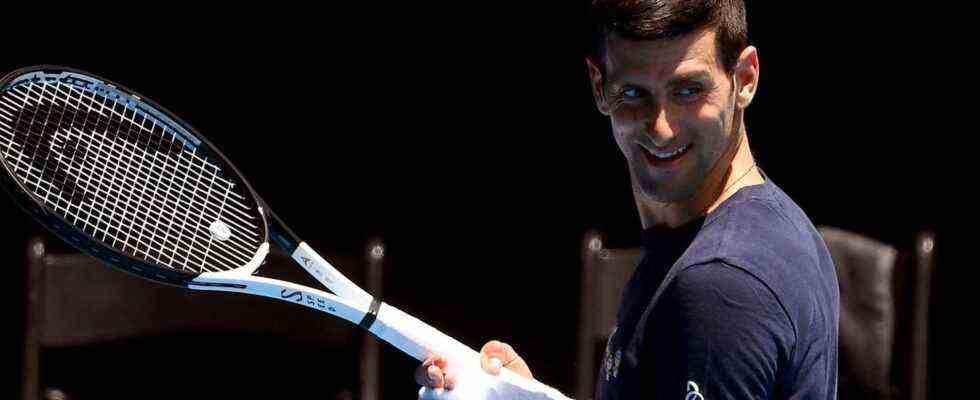IT collective research
Oddities in Djokovic’s PCR test: This is how experts identified conspicuous data
Novak Djokovic
© William West / AFP
A German IT collective discovered inconsistencies in the allegedly positive PCR test that Novak Djokovic submitted for the special permit to enter Australia – this is how the experts proceeded.
Novak Djokovic is still waiting for a decision from Australian Immigration Minister Alex Hawke. He had announced that he would withdraw the Serbian tennis star’s visa if it was based on incorrect information. Most recently, the attorneys for the world’s number one had submitted documents that first had to be checked, Hawke will not comment before Thursday.
Perhaps the minister will deal with the research results of the German IT collective Zerforschung, which took a closer look at the two digital PCR test certificates that Djokovic presented for the visa. Accordingly, Djokovic tested positive for Covid-19 on December 16. A second PCR test was carried out on December 22nd, which produced a negative result. Everything was as it should be. Djokovic was considered to have recovered, received the special permit for unvaccinated persons from the Australian Tennis Association and on this basis successfully applied for an entry visa to participate in the Australian Open.
But there are considerable doubts about the correctness of the first PCR test, as the specialists from Zerforschung report. They have published the results of their research on Twitter and describe step by step how they carefully examined the tests. In a nutshell: Both the time stamp of the first PCR test and its identification number, both of which are specified in the digital vaccination certificate, should not match Djokovic’s information and the timing. According to this, Dojkovic’s PCR test, which is said to have been carried out on December 16, was only carried out on December 26. That would suggest that the 34-year-old and his management presented the positive test only afterwards in order to obtain an exemption for entry.
But how did the experts from Zerforschung go about it?
First of all, they grabbed the written versions of the test documents. Djokovic’s lawyers had presented Djokovic’s lawyers to the Melbourne court, which revoked the cancellation of his visa (the Australian authorities were known to have denied Djokovic entry despite his visa due to missing information) and all of them Documents published. The IT experts used the QR code on the documents to access the digital certificates, which are located on the website of the Serbian test register. There they only received the following information, as Zerfoschung writes on Twitter: “The name of the person tested, the test result and a test number.” But: “The test results page cannot be used to check when someone was tested.”
Nine people tell why they didn’t get vaccinated
11 images
To investigate this, the IT experts looked at the URLs, i.e. the exact Internet addresses of the digital test certificates. In it they discovered a so-called Unix time stamp (1641903476), which can be converted into a “human-readable point in time”, as the researchers write. the Unix timestamp is a “standard to represent points in time. The seconds have been counted up at midnight since January 1st, 1970 “.
The result does not match the official information provided by Djokovic and his lawyers. According to the timestamp, the first PCR test with a positive result was only created in the Serbian test registry on December 26th, and not on December 16th as the official version is. The information on the second PCR test, which is said to have been carried out on December 22nd and was negative, is therefore correct.
In a second step, the IT experts determined a “confirmation code” on the website with the digital certificates. Comparisons with other tests resulted in an upwardly increasing test ID, which “roughly corresponds to the number of PCR tests reported for Serbia at the time,” writes the group. The later the point in time, the higher this figure is. Here, too, doubts about the date are confirmed. The alleged first PCR test from December 16 (7,371,999) has a test ID 50,000 higher than the second from December 22 (7,320,919).
In addition, the difference of 50,000 corresponds roughly to the number of tests carried out in Serbia between December 22nd and 26th, write the researchers. This also corroborates the suspicion that the allegedly first, positive PCR test was registered in the system after the second on December 22nd. Between December 16 and 22, the number of PCR tests performed was approximately 75,000. The test ID of the first test should have been about this value lower.
In addition to the research presented by Zerforscht, there is another oddity in connection with the PCR tests: A journalist from “Racquet Magazin” and “Spiegel” scanned the QR code of the allegedly positive PCR test immediately after it was published the Melbourne court. To their surprise, the result was given as negative. Only on a second attempt did it change to positive.
In the meantime, Djokovic has admitted errors in the entry information and in behavior after his alleged corona infection. He did not comment on the peculiarities of the PCR tests.
Source: “Exploration”, “Tagesspiegel”, “The mirror”



